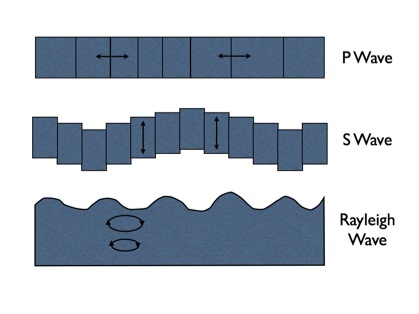Elastic solids support several different types of waves. Inside the material there is the possibility of two qualitatively different wave polarities. The first is called a compressive or P wave. For a plane wave of this type the particle motion is in the direction of wave propagation (the top diagram above). If you have a Slinky type toy, this is the type of wave you make by stretching the toy a bit and then pushing one end toward the other. The second type is called a shear, or S wave. In a plane wave, individual particles move perpendicular to the direction of wave propagation (the middle diagram above). Using a Slinky you would generate this wave by moving the spring side to side.
Both of these wave types are called body waves since they occur inside the elastic material. For a pure, elastic material they are not damped and are non-dispersive. In practice some amount of damping and scattering always takes place. Nevertheless, the long life of these waves makes them useful tools. On large scales they can be used to detect seismic activity or even nuclear explosions (the science of seismology), while on lab scales they can be used to probe the properties of materials without damaging the material (the science of nondestructive testing).
It is an interesting mathematical problem to think about how to distinguish P and S waves when the waves are no longer plane (think of an isolated source in the middle of a cube of elastic material). The solution comes from the classical Helmholtz decomposition of a vector into an irrotational and divergence-free part.
Elastic waves on the surface are called Rayleigh waves (see the bottom diagram above). For these waves particle motion is ellipsoidal (in analogy with water waves). These waves are the destructive part of an earthquake.
Waves in Solids


